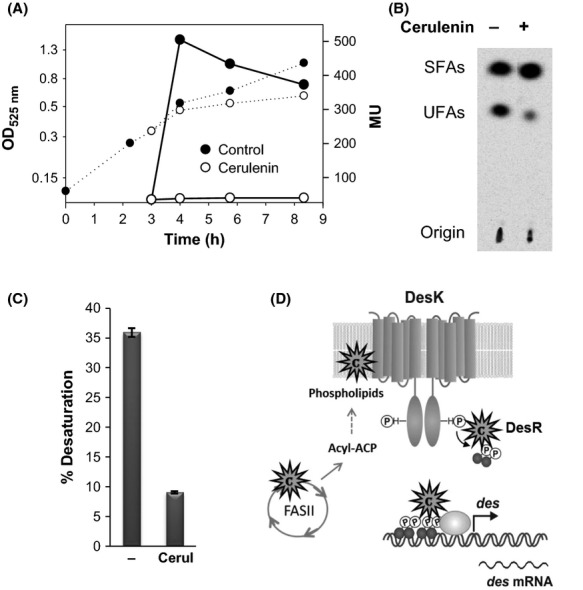Figure 2.

Effect of cerulenin on expression of des promoter and autoradiogram of the products of [14C]palmitate labeling. (A) Bacillus subtillisAKP3 cells (amyE::Pdes-lacZ, cerS) were grown in MM at 37°C to an OD525 of 0.35 and then cultures were split in two. One half was supplemented with cerulenin 2.5 μg mL−1 (white circles), while the other remained untreated (black circles), then cultures were transferred to 25°C. β-galactosidase-specific activities (in Miller units, MU) were determined at the indicated time intervals. Dotted lines: OD525; solid lines: β-galactosidase-specific activities. (B) UFAs synthesized by strain AKP3 after a temperature downshift, in the presence or the absence of cerulenin. Cultures were labeled with 0.2 μCi of [14C]palmitate and incubated at 25°C for 5 h, as described in Material and Methods. Lipids were extracted and transesterified; the resulting methyl esters were separated into saturated (SFAs) and unsaturated (UFAs) fractions by chromatography on silver nitrate-impregnated silica plates. About 11,000 cpm of radioactivity was loaded into all lanes. (C) Percentages of UFA synthesis. The radioactivity levels of the spots of the UFA and SFA shown in panel B were quantified by ImageQuant 5.2. Results are expressed as percentages of the total methyl esters recovered. Values are the average of three independent experiments. (D) Cerulenin could block different steps in the transmission of the cold signal. The putative sites of action of cerulenin are indicated as asterisks.
